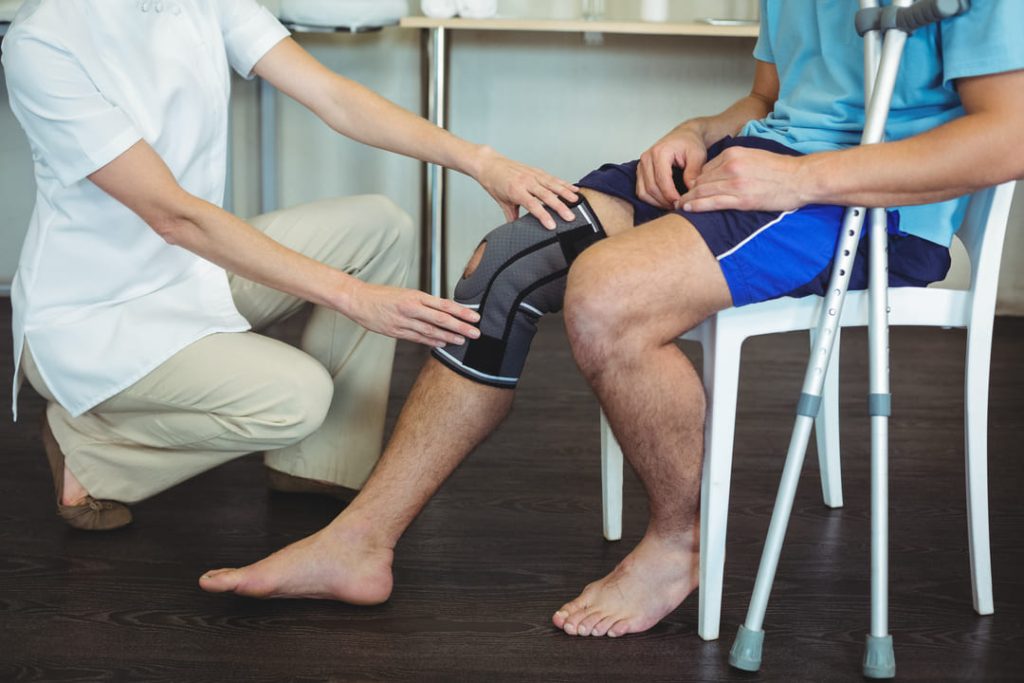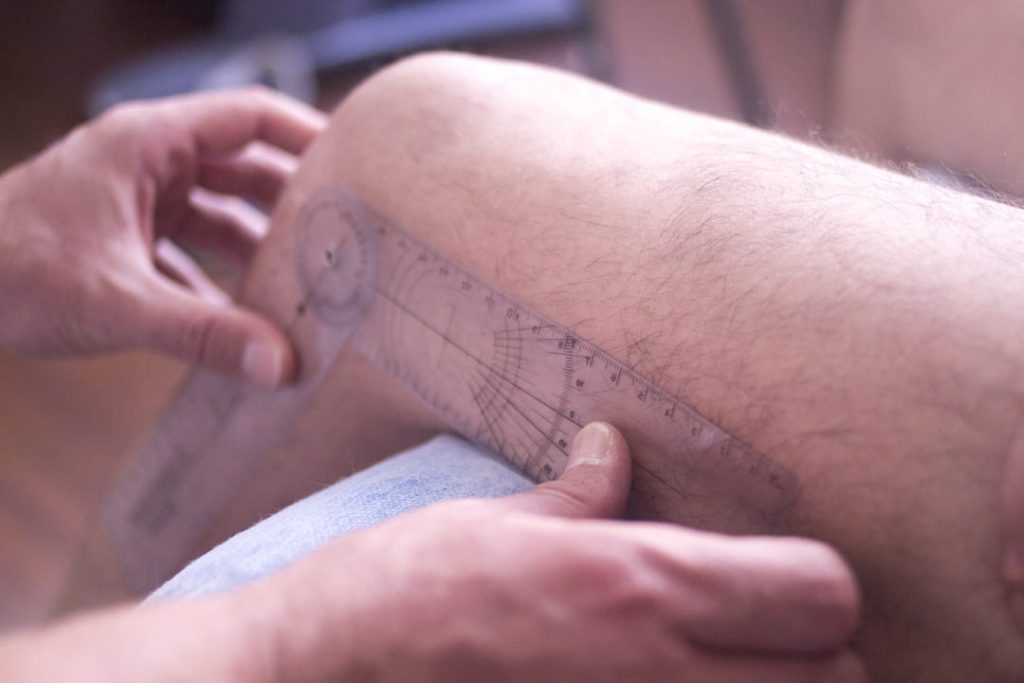Looking for Expert-Level VA Claim Answers?📱Call Us Now! 737-295-2226
Service members are often on their feet and performing heavy lifting, so it’s no surprise that limited flexion of the knee ranks high on the list of the most common VA disabilities.
The VA knee rating chart assigns disability ratings from 10% to 60% (and even a temporary 100% after surgery) based on the level of knee pain and its frequency, severity, and duration.
In this guide, we break down how the VA rates knee pain, which conditions qualify, and what you need to do to strengthen your claim.
Understanding what you qualify for can be confusing, but we’ve got you covered!
Summary of Key Points
- The VA knee rating chart assigns 10%–60% disability ratings depending on the severity of your knee condition; temporary 100% ratings apply after surgeries like replacements.
- Ratings are based on range of motion (flexion/extension), instability, and ankylosis, with diagnostic codes such as DC 5256, DC 5257, DC 5260, and DC 5261.
- Common knee conditions that qualify for VA disability include osteoarthritis, subluxation, bursitis, effusion, hyperextension, and ankylosis.
- To win a VA knee pain claim, you need a current diagnosis, medical evidence of service connection, and supporting documentation from exams or providers.
How the VA Rates Knee Pain

The VA Knee Rating Chart assigns a rating of 10%-60%, depending on the condition’s severity. In addition, if the pain requires surgery, you may receive a temporary VA rating of 100% post-op.
For example, knee resurfacing or knee replacement surgery is listed under diagnostic code (DC) 5055, and the VA will pay 100% for four months after your surgery date.
The VA rates knee conditions under the Title 38 CFR knee rating chart, Part 4, Schedule for Rating Disabilities, DC 5257, Knee Impairment, although “Unfavorable Ankylosis of the Knee” is rated under DC 5256, with ratings between 30%-60%.
However, since many knee conditions may qualify for disability, finding the correct one for you can be tricky, so having a service-connected diagnosis is crucial.
The VA knee rating chart often considers flexion (to what degree the knee can bend) and extension (to what degree the knee can straighten). Normal flexion of the knee is typically between 135 and 140°, with a normal extension between 0 and -10°.

VA Knee Rating Chart for Pain
| DC 5257, Knee Pain: | VA Rating |
| Recurrent subluxation or instability: | |
| Unrepaired or failed repair of complete ligament tear causing persistent instability, and a medical provider prescribes both an assistive device (e.g., cane(s), crutch(es), walker) and bracing for ambulation | 30% |
| One of the following: | |
| (a) Sprain, incomplete ligament tear, or repaired complete ligament tear causing persistent instability, and a medical provider prescribes a brace and/or assistive device (e.g., cane(s), crutch(es), walker) for ambulation. | 20% |
| (b) Unrepaired or failed repair of complete ligament tear causing persistent instability, and a medical provider prescribes either an assistive device (e.g., cane(s), crutch(es), walker) or bracing for ambulation | 20% |
| Sprain, incomplete ligament tear, or complete ligament tear (repaired, unrepaired, or failed repair) causing persistent instability without a prescription from a medical provider for an assistive device (e.g., cane(s), crutch(es), walker) or bracing for ambulation | 10% |
VA Rating for Unfavorable Ankylosis of the Knee
| DC 5256, Ankylosis of the Knee: | VA Rating |
| Extremely unfavorable, in flexion at an angle of 45° or more | 60% |
| In flexion between 20° and 45° | 50% |
| In flexion between 10° and 20° | 40% |
| Favorable angle in full extension or in slight flexion between 0° and 10° | 30% |
VA Rating for Limitation of Flexion
| DC 5260, Leg, Limitation of Flexion | VA Rating |
| Flexion limited to 15° | 30% |
| Flexion limited to 30° | 20% |
| Flexion limited to 45° | 10% |
| Flexion limited to 60° | 0% |
VA Rating for Limitation of Extension
| DC5261, Leg, Limitation of Extension | VA Rating |
| Flexion limited to 45° | 50% |
| Flexion limited to 30° | 40% |
| Flexion limited to 20 ° | 30% |
| Flexion limited to 15° | 20% |
| Flexion limited to 10° | 10% |
| Flexion limited to 5° | 0% |
What Knee Problems Qualify for Disability?
Several knee problems could qualify you for VA disability compensation and benefits. Remember, submitting a claim doesn’t automatically guarantee you will receive compensation, but it’s a necessary step in getting the benefits you deserve.
Common veteran knee conditions
- Instability of the knee – The feeling of having your knee move side to side when doing simple activities.
- Osteoarthritis – The most common form of arthritis causes the joint’s cartilage to break down and change the underlying bone structure.
- Subluxation – A partial dislocation of the knee causing pain, swelling, and immobility.
- Ankylosis – Stiffness of the knee that prevents movement, usually caused by injury or disease.
- Osteomyelitis – An infection of the bone and marrow and can have periods of activity and inactivity.
- Effusion – A swollen knee due to excessive fluid around the joints.
- Hyperextension – There’s been an excessive movement of a joint in one direction (straightening). In other words, the joint has been forced to move beyond its normal range of motion.
- Bursitis – A painful condition that affects the small, fluid-filled sacs-called bursae (bur-SEE)-that cushion the bones, tendons, and muscles near your joints. Bursitis occurs when bursae become inflamed.
Veterans experiencing one of the above conditions should work on establishing a connection between the pain and their military service. Reviewing the VA knee rating chart will assist you in determining what condition you may have.
Can I Get VA Compensation for Knee Pain?
Yes! Veterans with knee pain connected to their service may be eligible for compensation. The frequency, severity, and duration of your disability will help determine your final rating from the VA Knee Rating Chart.
Unfortunately, pain alone isn’t a diagnosis. You must receive an official diagnosis of a medical condition and prove that it’s service-connected to be eligible for VA compensation. However, knee pain is often a sign of an underlying condition and can help qualify you for a VA rating.
You can qualify for compensation if your knee condition is due to your time in the service, or you can prove your duty worsened a pre-existing knee condition. However, you must provide a VA service connection by aggravation to prove your disability worsened due to active duty.
In addition, the VA uses compensation and pension (C&P) exams to assess knee pain and its impact on your life. The outcome will help determine whether there is a link or connection between your condition and military service.
Watch our VA C&P Exam: 10 Things to Know Before You Go (*NEW* TIPS!) for helpful information before going to your C&P exam.
How Do I Get a VA Rating for Knee Pain?
You must take specific steps to receive a knee pain VA rating. The more evidence you have to prove your condition, the greater your chance of winning your claim.
Three main ways to get a VA rating for knee pain
| Direct Service Condition | This means that a particular disease or injury was incurred in service. This is accomplished by affirmatively showing inception during service | VA rating: 10%, 20%, or 30% |
| Secondary Service Connection | Veterans can be rated for disabilities that are proximately due to, or the result of, a service-connected (SC) condition | VA rating: 10%, 20%, or 30% |
| Unfavorable Ankylosis of the Knee | When you can’t bend it past certain degrees, measured by a Goniometer | VA rating: 30%, 40%, 50%, or 60% |
See also: 3 Best Ways to Get a VA Rating for Knee Pain
Conclusion
You’re not alone if you experience knee pain due to your time in the service.
If your knee pain is connected to your military service, you may be entitled to VA benefits and compensation. The 38 CFR knee rating chart requires an understanding of your diagnosis before determining your VA rating.
While most knee pain ratings vary from 10%-60%, it will depend on the severity of your case, especially if you require surgery. Remember, don’t hesitate to get a second opinion if you are unsatisfied with an initial response.
NEED MORE ASSISTANCE?
Understanding the VA Knee Rating Chart can get confusing, but we’re here to help you. Most veterans are underrated for their disabilities and, therefore, not getting their due compensation. At VA Claims Insider, we help you understand and take control of the claims process so you can get the rating and compensation you’re owed by law.
Our process takes the guesswork out of filing a VA disability claim and supports you every step of the way in building a fully-developed claim (FDC)!
If you’ve filed your VA disability claim and have been denied or have received a low rating—or you’re unsure how to get started—reach out to us! Take advantage of a VA Claim Discovery Call. Learn what you’ve been missing—so you can FINALLY get the disability rating and compensation YOU DESERVE!
FAQs
Can I get VA disability compensation for knee pain?
Yes, but pain alone is not enough. You must have a formal medical diagnosis (such as arthritis, instability, or bursitis) and show that the condition is connected to your military service.
What is the highest VA rating for knee pain?
Most knee conditions are rated from 10% to 60%, depending on severity. However, knee replacement surgery under DC 5055 can qualify for a temporary 100% VA rating for four months following surgery.
What evidence do I need for a VA knee pain claim?
You’ll need a medical diagnosis, service records showing an in-service event or injury, and a medical nexus linking your condition to service. A C&P exam may also help establish severity.
Can I get VA benefits if my military service made a pre-existing knee problem worse?
Yes. This is called service connection by aggravation. If you can show your service worsened a pre-existing knee condition beyond its natural progression, you may qualify for benefits.
Author

Kelly Olone
Kelly Olone is a military spouse who earned her degree in Psychology from Florida International University. After working in the non-profit sector for several years, she turned to her passion for writing. She aims to contribute to a better understanding of the valuable benefits that veterans deserve. As a mom, Kelly navigates the delicate balance between deadlines and bedtime stories with finesse.

Quality Assurance Team
The Quality Assurance (QA) team at VA Claims Insider has extensive experience researching, fact-checking, and ensuring accuracy in all produced content. The QA team consists of individuals with specialized knowledge in the VA disability claims adjudication processes, laws and regulations, and they understand the needs of our target audience. Any changes or suggestions the QA team makes are thoroughly reviewed and incorporated into the content by our writers and creators.



